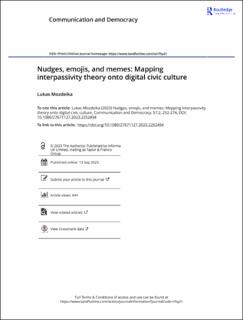| dc.contributor.author | Mozdeika, Lukas | |
| dc.date.accessioned | 2024-02-01T08:10:56Z | |
| dc.date.available | 2024-02-01T08:10:56Z | |
| dc.date.created | 2023-11-01T11:08:16Z | |
| dc.date.issued | 2023 | |
| dc.identifier.citation | Communication and Democracy. 2023, 57 (2), 252-274. | en_US |
| dc.identifier.issn | 2767-1127 | |
| dc.identifier.uri | https://hdl.handle.net/11250/3114965 | |
| dc.description.abstract | Once lauded for liberating audiences from their passive state by
granting voice, the digital public sphere today increasingly resem-
bles a cacophony of disjointed voices datafied for the gain of giant
tech firms. Instead of bemoaning the co-optation of users’ activity,
we might find it timely to reconsider the possibility that users’
passivity might be at stake, the key assumption of interpassivity
theory implying a delegation of one’s affective subject position
under seeming interactive practices. This article reviews burgeon-
ing research on interpassivity and brings it to bear on pervasive
phenomena in digital interactive environments: nudges, emojis,
and memes. Tracing the artificial canned laughter of the broadcast
era to the famous internet adage, Poe’s law, I argue that strategic
ambivalence, vitriolic joking, and irony weaponized by far-right
online subcultures exploit the interactive nudge logic of social
media affordances. The means of expressing authentic feelings
afforded by digital media entail a fissure that trades in illusions
which users disavow. This explains how surprising phenomena
beyond belief, such as “meme magic,” gain symbolic power. The
theoretical takeaway upends the key premise of cultural participa-
tion theory suggesting that rather than serving as a precondition,
relentless interactivity might paradoxically undermine the demo-
cratic ethos of participatory culture. | en_US |
| dc.language.iso | eng | en_US |
| dc.rights | Attribution-NonCommercial-NoDerivatives 4.0 Internasjonal | * |
| dc.rights.uri | http://creativecommons.org/licenses/by-nc-nd/4.0/deed.no | * |
| dc.title | Nudges, emojis, and memes: Mapping interpassivity theory onto digital civic culture | en_US |
| dc.type | Peer reviewed | en_US |
| dc.type | Journal article | en_US |
| dc.description.version | publishedVersion | en_US |
| cristin.ispublished | true | |
| cristin.fulltext | original | |
| cristin.qualitycode | 1 | |
| dc.identifier.doi | 10.1080/27671127.2023.2252494 | |
| dc.identifier.cristin | 2190962 | |
| dc.source.journal | Communication and Democracy | en_US |
| dc.source.volume | 57 | en_US |
| dc.source.issue | 2 | en_US |
| dc.source.pagenumber | 252-274 | en_US |

